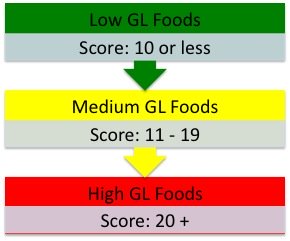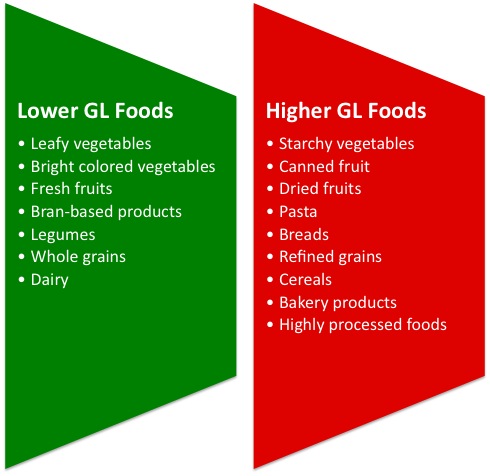{STEP 2.4} Use our Guide to the Glycemic Load
Mastering our guide to the glycemic load will give you a real advantage in creating a lifelong healthy diet that is successful. Carbohydrates are essential and self-regulation of your blood glucose levels is a key factor in allowing your body to work at maximum efficiency.
Using the glycemic load as a tool to help us choose the best carbohydrates will keep our blood sugar levels relatively even and prevent unnecessary stress on our bodies. If this all seems foreign, don't worry!
Our guide to the glycemic load will start with the basics and work our way towards how to use it as a valuable tool in your healthy diet plan.
The glycemic load (GL) is an arbitrary number that is based on how our body's blood glucose level reacts when we eat different carbohydrate-rich foods. The GL is a practical extension of a system known as the glycemic index introduced in 1981 to help diabetic patients manage their condition more naturally and become less dependent on the use of injected insulin.
Foods with a high GL produce a large spike in blood glucose levels. The sudden response needed by insulin to regulate these levels is stressful on our body and can be harmful over time.
Repeated sharp spike and drops is a leading cause to the onset of adult diabetes. On the other hand, low GL foods keep our blood sugar levels in balance without excessive need for insulin.
Pure glucose is the simplest of all carbohydrates and is the benchmark for comparison to all other foods. It has a score of 100 on the glycemic index, the highest possible score on the 0-100 scale . However, this measurement system accounts only for a particular food's effect on blood sugar levels, but not for the amount of food eaten. Let's see why the glycemic load is a superior measurement.
For example, watermelon has a notoriously high glycemic index value of 72. All foods in the glycemic index are calculated based on a standard 50 grams of carbohydrates sample. In order to eat enough watermelon to equal 50 grams of carbs, you would need to eat over 4 cups of watermelon in one sitting. That's a lot of watermelon!
 |
A more reasonable portion would be one cup as a snack or part of a meal, which has a very low GL of 8, supplying 12 grams of energy in the form of carbohydrates. GL incorporates portion size along the glycemic index value of foods to create a much more relevant and useful measurement. This chart is at the core of this guide to the glycemic load. |
Why Should I Use the Guide to the Glycemic Load?
The ability to naturally control your blood sugar has many benefits. Perhaps the most obvious is the risk of developing diabetes, a disease that is an extreme case of blood sugar imbalance. Diabetes in adults develops when our body can no longer produce enough insulin, the hormone responsible for regulating our blood glucose levels.
Keeping our blood glucose levels even is also directly related to our energy level. When our blood sugar levels spike from eating carbohydrates that are quick-releasing, it subsequently causing an even greater spike by insulin as a response, which is an overcompensation technique and eventually results in a opposite downward spike in blood sugar levels.
This is the nutrition science behind the sugar high and crash. When we ingest superior carbohydrates that are slowly converted and released as sugars, we have a much more constant energy level.
When glucose in the bloodstream is low, we experience an array of feelings including irritability, inability to concentrate, and hunger. If we eat foods that quickly breakdown and release glucose to satisfy our hunger, insulin responds extracting excess glucose from the bloodstream and converting it to glycogen.
IMPORTANT TAKEAWAY:
When our liver and muscle glycogen stores are filled, our body begins to convert glucose to fat. Choosing foods that have a low glycemic load will release glucose at a slow and steady pace without risk of glucose conversion to fat.
Perhaps the most underappreciated and important benefit of creating a healthy diet plan based around slow-releasing, low GL carbs is the rich density of nutrients recieved by our body when we eat these foods.
Whether simple or complex, eating carbohydrates that have a low GL and by following this guide to the glycemic load will result in steady and constant blood sugar levels. Regulation of this level with your diet will avert risks associated with insulin resistance and produce long-term health and well-being.
Simple Advice for Choosing Foods
Choosing foods using our guide to the glycemic load is easy once we square away a few things. First of all, foods that have little or no carbohydrates as part of their nutrient profile aren't relevant to the glycemic load. Foods that have most of their calories in the form of carbohydrates are plant-based. The one notable exception is dairy, but only in low-fat or fat-free forms.
As it stands now, the most comprehensive of GL ranked foods was published by the American Journal of Clinical Nutrition. It can be used as your Guide to the Glycemic Load reference and has calculated values for hundreds of foods.
In conjunction with the Daily Food Guide we can simplify things even further, so you don't have to look at the GL values of foods every time you eat.
Carbohydrate-Rich Food Groups
- Vegetables
- Fruits
- Whole Grains
- Legumes
- Spices & Herbs
- Dairy (low and non-fat products)
Focusing on these food groups, we can break down each one and come up with some carbohydrate-rich foods that tend to be higher on the GL scale and should be eaten in smaller portions and infrequently, as well as those on the lower end of the GL scale that can be eaten in much larger portions without the risk of blood sugar spikes. Let's take a look...

Like What You're Reading?
We've now covered all the macronutrients - protein, fats & oils, carbohydrates - in creating your healthy diet plan. You are well on your way to a newer, healthier, and happier you! Give yourself a pat on the back, and let's continue on the journey together...
Action Steps
|
 |
The following articles will help you set guidelines and craft your plan.
- Daily Food Guide for Wellness of Body and Mind
- Protein in Diet should Always be High Quality
- Healthy Diet Fats are Real!
- A Guide to the Glycemic Load
- The Benefits of Vitamins: The Facts and the Fiction
- Water Nutrition: 3 out of 4 People Don't Drink Enough
**As always, feel free to use the navigation below to backtrack and get an overview of Healthy Diet Mentor and our plan to get you on your way to a lifelong healthy diet.